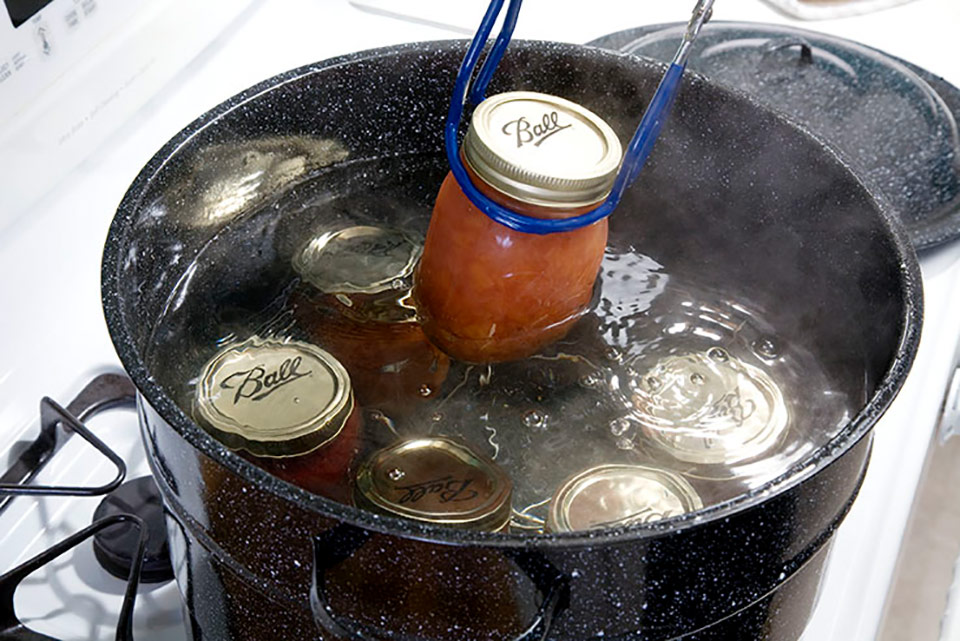Water Bath Canning Basics
The tasty high-acid menu includes choices ranging from sweet to savory. Fruits, fruit juices, jams, jellies and other fruit spreads, salsas, most tomatoes, pickles, relishes, chutneys, sauces, vinegars and condiments are among items safely preserved using the water bath canning method. Because these common foods contain high amounts of acid or the recipe incorporates the correct balance of acid, water bath canning is the recommended method.
Double-Check The Necessary Supplies:
Boiling water bath canner or a large, deep saucepot with a lid, and a rack.
Glass preserving jars, lids, and bands (always start with new lids).
Common kitchen utensils, such as a wooden spoon, ladle, and paring knife.
Quality ingredients (fresh fruits and vegetables).
Jar Lifter.
Home Canning Funnel.
The Water Bath Canning Process
Fill water bath canner at least half-full with water. Cover and maintain a simmer (180°F) until jars are filled and placed in canner.
Check jars, lids, and bands for proper functioning. Jars with nicks, cracks, uneven rims or sharp edges may prevent sealing or cause jar breakage. The underside of lids should not have scratches or uneven or incomplete sealing compound as this may prevent sealing. Bands should fit on jars. Wash all in hot, soapy water and dry well.
Pre-heat your canning jars in hot (180°F) water. Keeping jars hot prevents them from breaking when filled with hot food. Leave lids and bands at room temperature for easy handling.
It is not necessary to purchase special cookware for water bath canning. A large, deep saucepot equipped with a lid and a rack works well. As long as it is large enough to fully immerse the jars in water by 1-2 inches – and allow the water to boil rapidly when covered – the pot is adequate. If you don’t have a rack designed for home preserving, use a cake cooling rack or extra bands tied together to cover the bottom of the pot.
Prepare the desired tested high-acid preserving recipe.
Use a jar lifter to remove the pre-heated jar. Fill jar one at a time with prepared food using a jar funnel, leaving headspace recommended in recipe. Remove air bubbles, if stated in the recipe, by sliding a rubber spatula between the jar and food to release trapped air. Repeat around jar 2-3 times. For successful sealing, you need to leave the correct amount of space between the food and the rim of the jar.
Wipe the rim and threads of the jar using a clean, damp cloth to remove any food residue. Center lid on the jar, allowing sealing compound to contact the jar rim. Apply band and adjust until fit is fingertip-tight. Place jar in canner. Repeat steps 4 and 5 until all jars are filled. Ensure water covers jars by 1-2 inches.
Place lid on water bath canner and bring water to a rolling boil. Begin processing time.
Process in the boiling water for the time indicated in tested preserving recipe. When complete, shut off heat and remove the lid. Allow jars to rest in canner for 5 minutes to be acclimated to the outside temperature.
Move jars from canner and set upright on a towel. This will prevent jar breakage that can occur from temperature differences. Leave jars undisturbed for 12 to 24 hours. DO NOT retighten bands as this may interfere with the sealing process.
Inspect lids for seals. There should be no flex when center is pressed. Remove the bands and attempt to lift lids off with your fingertips. Properly sealed lids will remain attached. If a lid fails to seal within 24 hours, immediately refrigerate the product. Clean canning jars and lids, label and store in a cool, dry, dark place for up to for up 18 months.

